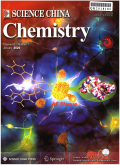- 钛学术文献服务平台 \
- 学术期刊 \
- 基础科学期刊 \
- 自然科学总论期刊 \
- 中国科学:化学(英文版)期刊 \
Synergistic effect of solvent and solid additives on morphology optimization for high-performance organic solar cells
Synergistic effect of solvent and solid additives on morphology optimization for high-performance organic solar cells
基本信息来源于合作网站,原文需代理用户跳转至来源网站获取
摘要:
Controlling the photoactive layer morphology towards nanoscale bi-continuous donor/acceptor interpenetrating networks is a key issue to build high-performance organic solar cells (OSCs).Due to the distinct properties between donor and acceptor materials,casting an active layer from a single solvent solution usually results in either insufficient or excessive phase separation that reduces the device performance.In comparison to the fullerene acceptors with closed-cage structures,the currently dominant non-fullerene acceptors possess the similar anisotropic π-π interactions with p-type organic semiconductor donors,giving rise to the complexity of the morphology regulation.Herein,we employ 4,4'-dimethoxyoctafluorobiphenyl (OFP) with strong crys-tallinity as a volatile solid additive to optimize the active layer morphology of OSCs.The synergistic effect of 1-chlor-onaphthalene (CN) and OFP as dual additives shows supreme capability on optimizing the morphology over the conventional additive of CN,which is in favor of improving charge transport and suppressing charge recombination for higher fill factors in various systems.In particular,the PTQ10:m-BTP-C6Ph-based device processed by the additive showed a remarkable power-conversion efficiency (PCE) of 17.74%,whereas the control device processed by CN additive yielded a relatively lower PCE of 16.45%.

推荐文章
Rapid and sensitive method for determining free amino acids in plant tissue by high-performance liqu
HPLC
OPA
FMOC
Free amino acids
Plant
PLS-DA
Effect of Zn deficiency and excessive bicarbonate on the allocation and exudation of organic acids i
Adaptation
Excessive bicarbonate
Organic acids
Organs
Root exudates
Zn deficiency
Influence of the biological carbon pump effect on the sources and deposition of organic matter in Fu
Carbonate weathering
Hydrochemical variation
Biological carbon pump effect
Sediment trap
Autochthonous organic carbon
Carbon sink
内容分析
关键词云
关键词热度
相关文献总数
(/次)
(/年)
文献信息
| 篇名 | Synergistic effect of solvent and solid additives on morphology optimization for high-performance organic solar cells | ||
| 来源期刊 | 中国科学:化学(英文版) | 学科 | |
| 关键词 | |||
| 年,卷(期) | 2021,(11) | 所属期刊栏目 | ARTICLES |
| 研究方向 | 页码范围 | 2017-2024 | |
| 页数 | 8页 | 分类号 | |
| 字数 | 语种 | 英文 | |
| DOI | |||
五维指标
引文网络
引文网络
二级参考文献 (0)
共引文献 (0)
参考文献 (0)
节点文献
引证文献 (0)
同被引文献 (0)
二级引证文献 (0)
2021(0)
- 参考文献(0)
- 二级参考文献(0)
- 引证文献(0)
- 二级引证文献(0)
引文网络交叉学科
相关学者/机构
期刊影响力
中国科学:化学(英文版)
主办单位:
中国科学院
出版周期:
月刊
ISSN:
1674-7291
CN:
11-5839/O6
开本:
16开
出版地:
北京东黄城根北街16号
邮发代号:
创刊时间:
1950
语种:
eng
出版文献量(篇)
4060
总下载数(次)
0
总被引数(次)
11421
期刊文献
相关文献
推荐文献
- 期刊分类
- 期刊(年)
- 期刊(期)
- 期刊推荐
力学
化学
地球物理学
地质学
基础科学综合
大学学报
天文学
天文学、地球科学
数学
气象学
海洋学
物理学
生物学
生物科学
自然地理学和测绘学
自然科学总论
自然科学理论与方法
资源科学
非线性科学与系统科学
中国科学:化学(英文版)2022
中国科学:化学(英文版)2021
中国科学:化学(英文版)2020
中国科学:化学(英文版)2019
中国科学:化学(英文版)2018
中国科学:化学(英文版)2017
中国科学:化学(英文版)2016
中国科学:化学(英文版)2015
中国科学:化学(英文版)2014
中国科学:化学(英文版)2013
中国科学:化学(英文版)2012
中国科学:化学(英文版)2011
中国科学:化学(英文版)2010
中国科学:化学(英文版)2009
中国科学:化学(英文版)2008
中国科学:化学(英文版)2007
中国科学:化学(英文版)2006
中国科学:化学(英文版)2005
中国科学:化学(英文版)2004
中国科学:化学(英文版)2003
中国科学:化学(英文版)2002
中国科学:化学(英文版)2001
中国科学:化学(英文版)2000
中国科学:化学(英文版)2021年第7期
中国科学:化学(英文版)2021年第6期
中国科学:化学(英文版)2021年第5期
中国科学:化学(英文版)2021年第4期
中国科学:化学(英文版)2021年第3期
中国科学:化学(英文版)2021年第2期
中国科学:化学(英文版)2021年第12期
中国科学:化学(英文版)2021年第11期
中国科学:化学(英文版)2021年第1期

 免费查重
免费查重










